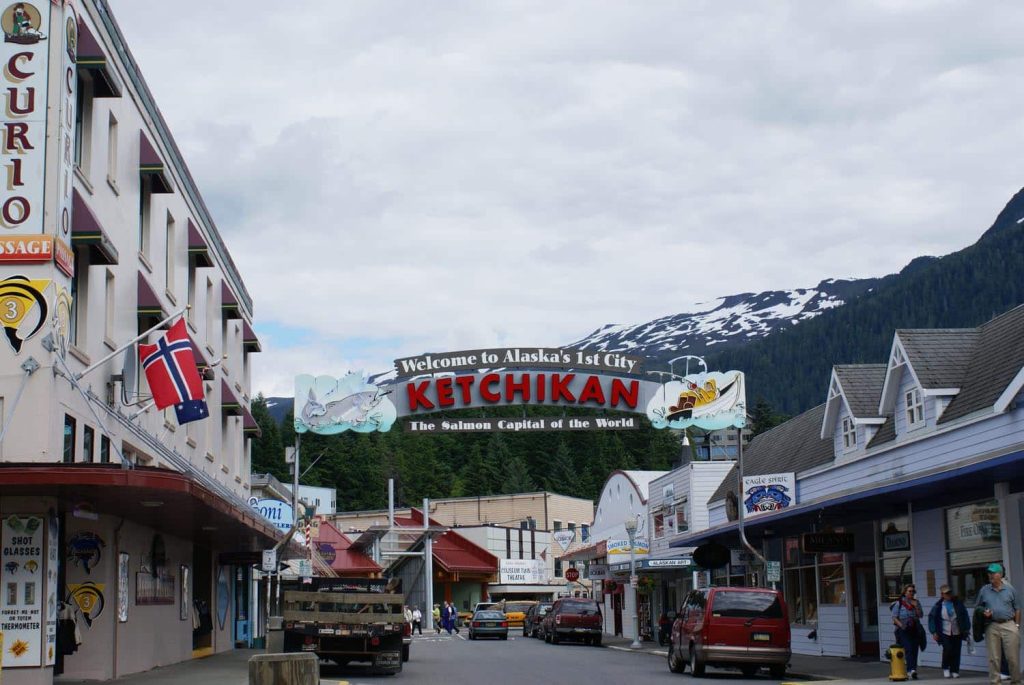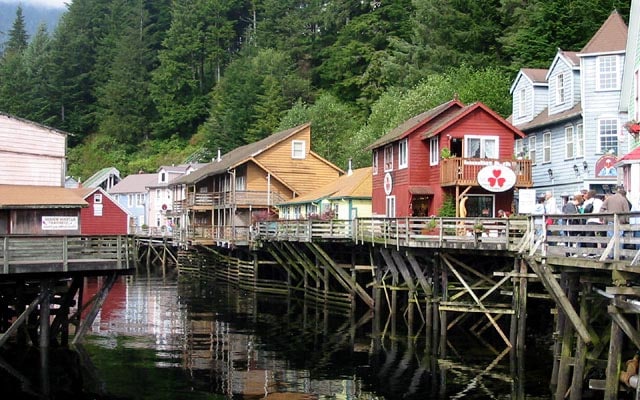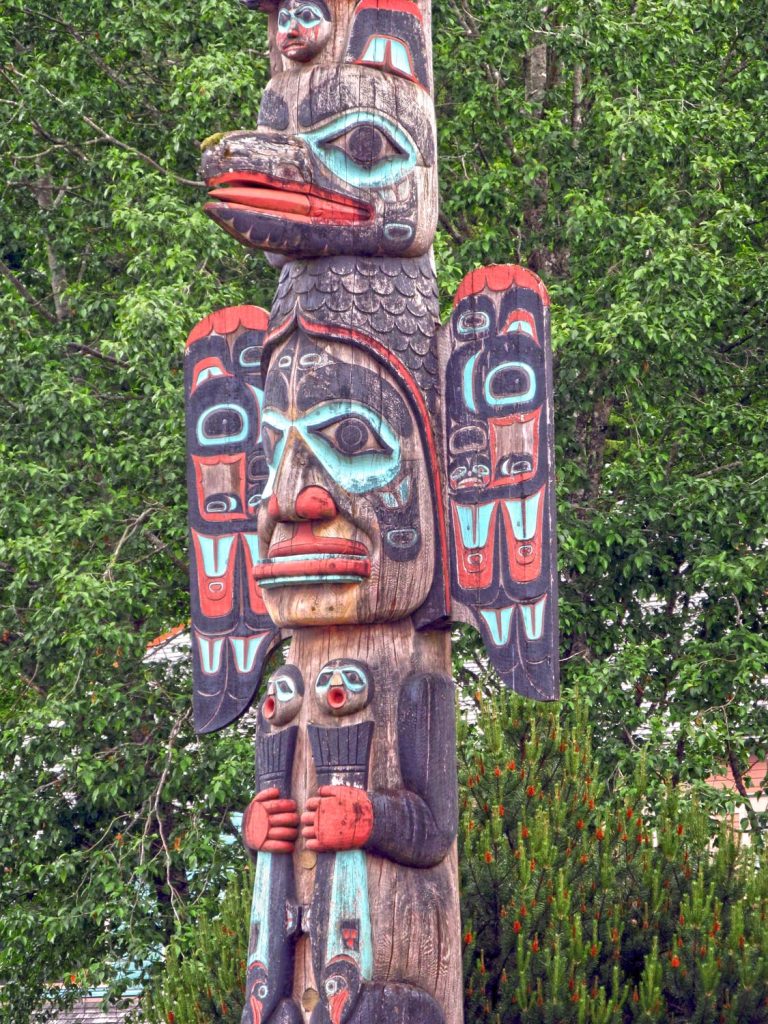Many RVers dream of traveling to Alaska, considering it the ultimate destination on their bucket lists. So we’ve created a series of articles to help you navigate the Last Frontier in a motorhome or travel trailer, in hopes that you can enjoy exploring the 49th state, as well!

Today we’ll visit Ketchikan:
Ketchikan
Used as a fish camp by the Tlingit people for many years, Ketchikan became an official town in 1885. Mike Martin was sent to the area from Oregon, looking for prospective sites for a fish cannery. Out of a partnership with George Clark came the Clark and Martin Saltery, built in 1886. Because of their initial efforts, Ketchikan is today known as the “Canned Salmon Capital of the World.”

By the 1890s, the discovery of gold and copper nearby brought prospectors of another sort, and the community became a mining supply town for a number of years. As with most towns, growth brings with it the need for more housing, with the surrounding spruce forests providing construction materials for homes and more canneries. A spruce mill and a pulp mill were added to the town, making it a good supplier for the logging industry.

These days tourism has taken a front seat, with cruise ships pulling into port on a daily basis. You can bring your RV, but it will have to arrive by ferry boat on the Alaska Maritime Highway, as the town is located on Revillagigedo Island, and the only access is by sea or air. Park the motorhome and explore the town on foot, as most sites are within walking distance or by free shuttle.
Places to See
Today visitors gravitate toward a section of town with a shady history. Creek Street began as a couple of shacks built over the water on stilts. These cribs and brothels serviced many a miner or lumberjack between 1903 and 1954 and designated Creek Street as a busy “red light” district.
In fact, during the Prohibition, liquor was smuggled into some of the saloons and houses of ill repute along this route. Bootleggers brought Canadian whiskey by boat at high tide. Those establishments that wished to offer alcohol cut a trap door in the floor for fast and discreet delivery!

Today the bordellos have been replaced by shops and restaurants, all painted vibrant colors. However, one remaining bit of history remains: Married Man’s Trail was originally a muddy path through the forest that customers used to hide their comings and goings from the area. Now you, too, can take that “walk of shame,” but you’ll do it on a wooden staircase and boardwalk at the end of Creek Street.
Don’t miss the salmon ladder on the creek, which lies at the end of Married Man’s Trail. It’s a pretty amazing sight to watch as salmon struggle upstream to lay their eggs each season.
Ketchikan has a colorful and somewhat rowdy past, and its indigenous population has created unique works of art, mainly in the form of totem poles. Travelers flock to the area to explore the Totem Pole Heritage Center, which houses the world’s largest collection of historic totem poles, most dating over 100 years old.

The Southeast Alaska Discovery Center downtown offers a concise overview of Ketchikan’s history and natural resources. Enter in front of three totem poles, each carved by a different local tribe: Tlingets, Haida and Tsimshian. Inside the center, you’ll find interpretive displays covering the native traditions, histories and the industries that have played a part in Ketchikan’s growth. A movie theater also presents stories of the city and her people.

If you are interested in discovering more about the rainforest environment in Ketchikan and the wildlife it harbors, checks out the Alaska Rainforest Sanctuary. Located on 40 acres just outside of town, the sanctuary has guided tours through the spruce and cedar forest to a protected estuary, where bears feed on the salmon of Eagle Creek. During spawning season you have a good chance of watching the feeding frenzy, with leftovers provided to resident eagles.
Visit a native clan house and authentic totem poles at Totem Bight State Historical Park. In the 1930s, many of the old villages were disappearing and with them the totems carved in each area. So, the Civil Conservation Corps was dispatched to collect the old poles in an effort to save them. Thus began Totem Bight. Natives were hired to restore or recreate the old totems, so two things were accomplished—young tribal members learned the art of carving and native histories were saved.

You’ll find 13 totems in the park, along with a clan house that held 30 to 50 family members. The totems all face out to sea as a display to those approaching, the carvings telling of the village’s history and wealth. A self-guided tour is well worth the effort.
To see more native artworks, take a free shuttle from downtown to Saxman Native Village. At the village, you can indulge in totem pole overload, with a clan house that has four carved posts inside, as well. To top it off, Saxman has a carving center, where visitors can watch native carvers in action. Self-guided tours are available, and many cruise ships book tours here that include native dances displays. Here’s a map with totem animal descriptions and interpretations.
Activities
Ketchikan is surrounded by water and forest, and locals know how to use their natural resources to their best benefit. Why not follow their lead?
Have you ever wondered what it would feel like to fly through the forest canopy? Well, you can find out at the Ketchikan Zipline Adventure Park. Careen over eight ziplines and test your balance on swaying logs and rope loops. Land on a platform 50 feet above the water, and bring your trip to an end on the forest floor. A climbing tower is also available for more proof of your bravery and prowess.

Fishing is always a given when the Pacific Ocean lies out your front door, but a tour on the Aleutian Ballad will give you an experience you won’t soon forget. Highlighted on the Discovery Channel’s “Deadliest Catch,” this boat normally fishes in the Bering Sea. However, you can ride the Inside Passage with the crew as they check their fishing gear along the way on the Bering Sea Crab Fishermen’s Tour. Crab pots and octopus pots are harvested, as well. Several animals that are caught are put in a live tank for passengers to see, while the others are gently released. Along the way, you may also spy bear, bald eagles, seals and much more from the calm waters around Annette Island.

Logging is still a viable industry in the area, and Ketchikan celebrates that part of their history with the Great Alaskan Lumberjack Show. Watch world-class athletes or “iron jacks” compete against one another using their brute strength, an ax, and a chainsaw. Click here for a little sample of what you can see.
Rain and More Rain
Ketchikan receives an average of 153 inches of rain each year. Much of it in the winter months. So, locals have discovered a way to endure through winter. Art has become a saving grace, and studio work that is created during the rainy season is put on display when Spring and Summer arrive.

Performances of every kind take top billing in town, including an annual production of The Nutcracker. Every month in the winter, the people of Ketchikan put on a variety show for each other called “The Monthly Grind.” For more than 30 years, a wearable art show hits the runways, displaying the work of creative fiber artists. Galleries dot the city, introducing visitors to bark basketry, carving, sculpture, painting, and many more fine arts created by local artisans.
Catch Ketchikan
This vibrant community thrives on the talents of its population, and lucky for us, they like to share their colorful town with travelers. Many visitors come on cruise ships or by seaplane, on ferry boats or by commercial airliner. Each experience the special relationship Ketchikan has with its heritage and the natural beauty of the land it inhabits. Make sure you add this city to your scheduled stops on your trip to Alaska!

Explore More of Alaska
Before you finalize your trip to The Last Frontier be sure to check out other Alaskan destinations here on the Camping World blog. You don’t want to miss a thing!
Author’s Note: If you will be driving through Alaska and/or Canada please consider purchasing a current copy of “The Milepost.” It is a travel guide that will list necessities (like gas stations) and amenities (like lodging) throughout Alaska and the western Canadian provinces by milepost marker. This is a prerequisite for traveling in the area, as distances between service stations and grocery stores can be hundreds of miles in many cases. Another piece of knowledge gleaned from “The Milepost” are the hours (and seasons) of operation of businesses along the route, as many close down during fall and winter.
What did you think of Ketchikan, Alaska? Leave a comment below.








